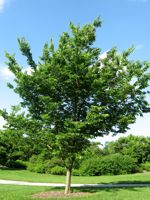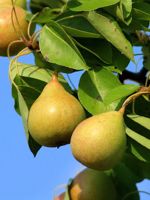Mon-Fri 9am - 5pm Mountain time
Common Hackberry vs Loving Pear
Celtis occidentalis
Pyrus Loving
COMING SOON
(new stock expected: later this season)
The Common Hackberry is a medium-sized deciduous tree that resembles the American Elm but is immune to Dutch Elm Disease. They are versatile and can adapt to a variety of growing conditions.
It produces purple-red, berry-like fruit with a large seed in the center. Both the sweet flesh, which tastes similar to dates, and the crunchy seed are edible. The fruit remains on the tree throughout the winter, offering a valuable food source for birds and other wildlife.
The Common Hackberry can also be a great addition to a pollinator garden. The tree itself is a host for the larvae of several butterfly species and the flowers provide a source of pollen and nectar.
Loving Pear is a Russian pear variety with a mild sweet flavor and a hint of sour. It is known for being cold hardy and disease resistant. They are green in colour but will transition to have a slightly golden red blush when ripe. With a minimal neck, they have a more rounded appearance.
They ripen in early September. It is recommended that they are harvested as the seeds begin to brown. They can finish ripening after picking. They keep well in cold storage and are suited for fresh eating, juicing, and dehydrating.
The Loving Pear requires a second variety for cross pollination. Some compatible varieties include Krazulya, Golden Spice, and others.

